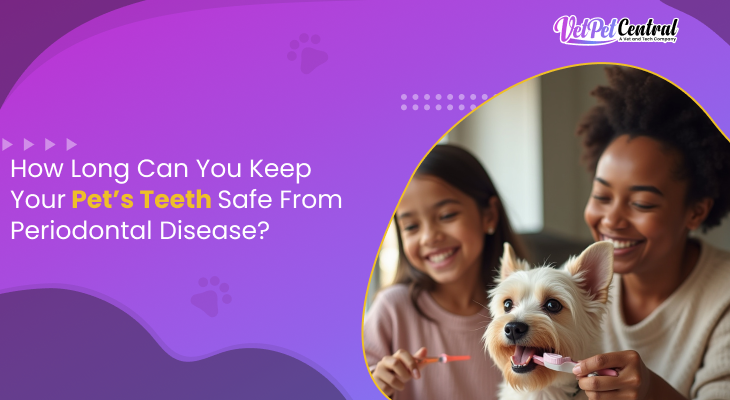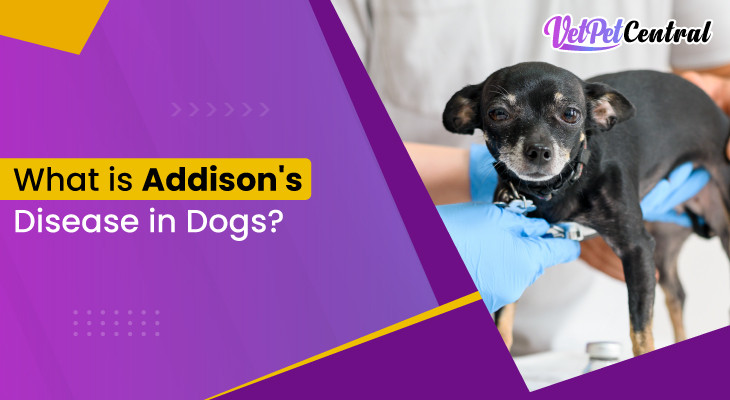How Long Can You Keep Your Pet’s Teeth Safe from Periodontal Disease?
 Feb 14, 2025
Feb 14, 2025

Pet parents mean you have to raise your furry friend, who is understood by emotions and appearance. This is a more cautious job than raising a dependent human who tells you easily what they need.
You have to look after the pet’s general health, dental care, skin coat, and overall well-being. The major concern that may grab your pet is periodontal disease, the most prevalent and easily avoidable oral health problem affecting pets.
This blog will discuss the necessary steps to protect your pet's teeth from periodontal disease.
Understanding Periodontal Disease
- Periodontal disease is:
- An infection and inflammation
- It affects the gums and supporting structures of the teeth
- It starts with:
- Plaque formation
- A sticky film of bacteria on the teeth
- If plaque is not removed, it:
- Hardens into tartar
- Requires professional cleaning for removal
- The bacteria in plaque and tartar cause:
- Gum inflammation
- Leading to gingivitis
- If gingivitis is untreated, it:
- Progresses to periodontitis
- Damages supporting structures of the teeth, including the bone
Signs of Periodontal Disease in Pets
Early detection is crucial in managing periodontal disease in cats or dogs. Some common signs include:
- Bad breath
- Red or swollen gums
- Yellow or brown tartar buildup on the teeth
- Bleeding gums
- Difficulty eating or chewing
- Loose or missing teeth
How Long Can You Keep Your Pet’s Teeth Safe?
The maintenance of your pet’s dental health mainly depends on how keenly you are adopting regular dental care.
So, if you spend good hours on your pet’s teeth, the likelihood of periodontal diseases is greatly reduced with the right preventative measures.
1. Routine Dental Check-ups:
Regular vet check-ups are crucial. Periodontal disease is a precursor to gum disease; therefore, the veterinarian will observe signs of periodontal disease and advise the pet to have its teeth professionally cleaned. Pets in good health must be taken to the dentist at least once a year, but those with mouth diseases are expected to visit more frequently.
2. Daily Dental Care at Home:
Daily teeth brushing is one of the most efficient ways to reduce a pet’s periodontal disease. You should use a pet-specific brush and, naturally, a pet toothpaste.
Brushing prevents tartar buildup by removing the accumulated pellicle film, which forms plaque.
If brushing is not possible, dental wipes and chews that help control plaque and tartar formation may also be useful products.
3. Proper Diet:
When it comes to feeding your pet, diet is one of the most critical aspects to consider.
Certain pet foods are made to aid in dental care by reducing the formation of plaque and tartar.
Consult a vet on which foods are preferable to feed your pet with the aim of enhancing oral health.
4. Dental Treats and Toys:
Treats and mouth toys are very useful for your pet's dental health. These products are intended to clean the teeth as the pet chews on them, eliminating plaque and stimulating the gums.
5. Water Additives:
There are water additives that one can use in their furry friend’s water bowls in order to minimize the formation of plaque and tartar. These additives are dropped in your pet’s drinking water and can be one of the easiest ways to attend to their dental needs.
Join the Local Block Party Webinar – Enhance Your Veterinary Knowledge

Advance your veterinary skills by attending the Local Block Party Webinar with Jennifer Mathis, DVM. Whether you're a seasoned professional or a student, this session will provide insights you can apply in your practice.
- Free virtual learning opportunity
- Earn 1 CE Credit from an accredited provider
- Gain knowledge from a leading industry expert
Date: Wednesday, February 26, 2025
Time: 8:00 PM Eastern Time
How to Prevent Periodontal Disease in Pets
Preventing periodontal disease in your pets comprises regular care and proactive measures.
Below are five key points to ensure your pet's dental health;
1. Regular Veterinary Check-ups
- Schedule annual or bi-annual dental exams for early detection and professional cleanings.
- Ensure professional cleanings under anesthesia to remove plaque and tartar effectively.
2. Daily Dental Care
- Brush your pet’s teeth daily with pet-specific toothbrushes and toothpaste
- Provide dental chews and toys to help reduce plaque and tartar buildup
3. Balanced Diet
- Feed high-quality pet food formulated to support dental health
- Limit sugary or starchy treats and avoid table scraps
4. Monitoring and Early Intervention
- Regularly check your pet’s mouth for signs of dental issues such as bad breath, swollen gums, or loose teeth
Seek immediate veterinary care or vet clinics if any dental problems are noticed
5. Other Preventive Measures
- Use water additives to reduce oral bacteria and plaque
- Encourage healthy chewing habits with appropriate toys and treats, and avoid bones or antlers
Here is a guide on how to prevent periodontal disease in dogs and cats. Read it and learn more information.
Can Teeth Be Saved with Severe Periodontal Disease?
Timely intervention is crucial in cases of severe periodontal disease.
If caught early, some teeth affected by periodontal disease can be saved through professional cleaning and treatment.
However, tooth extraction might be necessary in advanced cases to prevent further infection and pain.
Save Teeth from Gum Disease:
Early detection and consistent care are vital to save your pet’s teeth from gum disease.
Incorporating dental care into your pet’s daily routine can significantly reduce the risk of periodontal disease.
Here is a guide on how to manage dental diseases in dogs. Read it and learn more information.
At What Point Are Teeth Not Fixable?
The pet's teeth may not be fixable or repairable when;
- Extensive decay has destroyed a significant tooth proportion
- Substantial bone loss around the tooth
- A tooth is fractured or broken below the gumline
- Infection has spread to the root and surrounding tissues
Common indicators that a tooth is irreparable
- Persistent pain despite treatment
- Teeth becoming loose or shifting position
- Visible abscesses or swelling in the gums
- Recurrent infections or failed previous dental treatments
To Wrap Up!
By actively taking preventive measures for pet dental hygiene and routine check-ups, you can ensure quality life for your pet.
The basic question was, “How long can you keep your teeth with periodontal disease?”
The above discussion also suggests that you can keep your pet’s teeth healthy and strong for many years with diligent care and regular vet visits.
If your furry friend's health is good, you will truly enjoy the company and smile they will bring to your life.
At VetPet Central, we connect you with vet experts from all fields to address your furry friend's specific health concerns.
Explore and get an appointment today!




